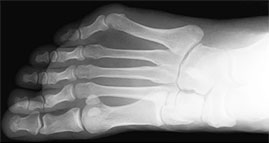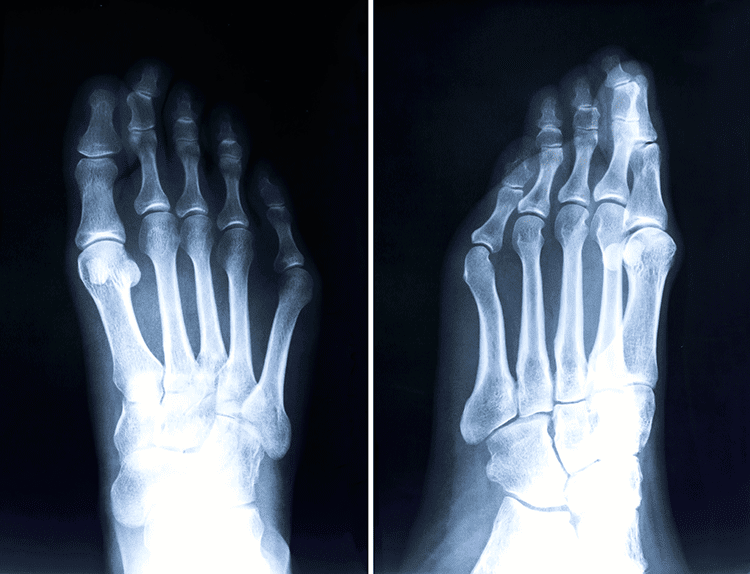What’s a Tailor’s Bunion?
A tailor’s bunion, also known as a bunionette, differs from a traditional bunion because it develops at the base of the baby toe instead of the side of the big toe.
Named because tailors used to sit cross-legged with the outside edge of their feet rubbing against the floor, producing an area of inflammation at the bottom of the baby toe.
What Causes a Tailor’s Bunion?
Tailor’s bunions are largely a product of genetics (a faulty mechanical structure of the foot). However, they can be made worse by wearing tight high heels or narrow shoes.
Also, our feet grow wider as we age, causing the foot to spread out and adding extra pressure to the area where a Tailor’s bunion would develop. Patients who fail to notice and continue to wear ill-fitting shoes run the risk of developing a bunionette.
Tailor’s Bunion Symptoms
There are several ways you can tell if you have a bunion. Sometimes you will feel (and usually see) a painful raised callus on the side of your foot, which was formed because the soft tissue over bone rubbed against the shoe.
Tailor’s bunion symptoms include varying degrees of pain, an unsightly bump on the outside of the small toe, and difficulty buying comfortable shoes.
How are Tailor’s Bunions Diagnosed?
Bunions, as well as bunionettes, are plainly visible to the doctor upon foot examination. If the anatomy of the foot is irregular, x-rays will probably be taken to understand the extent of the deformity.
Conservative Treatments for Tailor’s Bunion
There are a number of non-invasive treatment techniques that often bring relief to our patients through please remember that they never permanently correct the bunionette condition. These include:
Wear comfortable shoes to reduce Bunion symptoms
Wearing more comfortable shoes almost always helps relieve bunion pain. Wearing wider shoes and avoiding pointed or high-heeled shoes can help relieve symptoms.
Cushion the Bunion
Applying soft pads on the area to protect the prominent bone can help ease the pain of a tender bunion.
Icing the Bunion area
Icing the affected area can help reduce the swelling around the Tailor’s bunion.
Non-steroidal anti-inflammatory medications for Bunion discomfort
Over-the-counter oral non-steroidal anti-inflammatory medications such as Ibuprofen (Advil) can help reduce the pain and inflammation of the bunion.
Targeted Injections
Injected corticosteroid injections may be used over a short period of time if your doctor feels it may be an appropriate course of action.
Surgical Treatments for Tailor’s Bunion

If your podiatrist believes it is necessary to remove the deformity or if conservative treatment options have not provided adequate symptom relief, surgery may be recommended. Surgery can be straightforward, such as shaving or reducing the bone prominence in order to lessen pressure on your bunion from footwear.
In some cases, cutting or separating the 5th metatarsal (small toe) so it can be properly realigned is the best way to improve your overall foot mechanics.
What to Expect After Tailor’s Bunion Surgery
Immediately following surgery, patients are fitted with a stiff-soled shoe to protect the toes and keep the foot from bending. Crutches may be needed briefly after surgery, with a physical therapist often consulted to help you adapt.
You will probably wear a bandage or dressing for about a week following the procedure and any removable stitches are taken out in 10 to 14 days. If you had pins inserted during surgery they are typically removed in three or four weeks.
Your doctor will likely take x-rays during one of your follow-up visits to evaluate the healing process.
University Foot and Ankle Institute, The Right Choice For Your Tailor’s Bunion Treatment
University Foot and Ankle Institute is nationally recognized as a leader in the research of and treatments for a bunion. Our foot and ankle specialists work directly with manufacturers in the development of cutting-edge treatment and techniques to reduce recovery time and increase success rates.
Interested in a consultation? Please call (877) 736-6001 or request a consultation online. University Foot and Ankle Institute is conveniently located throughout Southern California with podiatry clinics in (or near) Santa Monica (on Wilshire Blvd.), Los Angeles, Beverly Hills, West Los Angeles, Sherman Oaks, and the San Fernando Valley, Manhattan Beach, and the South Bay, LAX, Westlake Village, Valencia, Santa Clarita, and Santa Barbara.
- Struggling with Toe Cramping and Curling? Here’s What To Do! - May 5, 2023
- Understanding Tailor’s Bunions: Causes, Symptoms, and Solutions - April 26, 2023
- Is that a Staph Infection? Dealing with an Infected Ingrown Toenail - February 22, 2023
